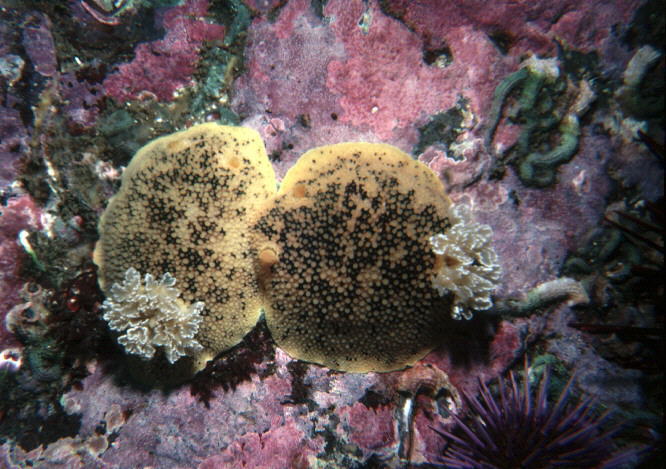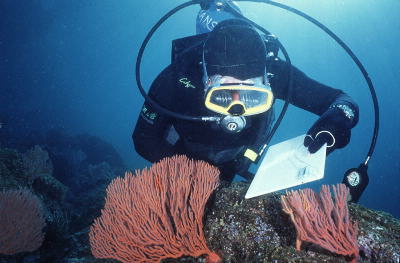 |
Anisodoris nobilis
Photographed at Arbolitos, Punta Banda, south of Ensenada, Baja California, Mexico, 25 feet deep
Anisodoris nobilis (MacFarland, 1905)
Frank Mace MacFarland himself established the first generic change of this species. As he wrote in his 1966 posthumously-published "Studies of Opisthobranchiate Mollusks": "In my peliminary paper of 1905, a new genus, Montereina, was proposed for a species which differed strikingly from the other Archidoridinae. The description was written in 1894 as it appeared in the paper cited above. Unfortunately, the important paper of Bergh (1898) upon the Opisthobranchs of Chile based on the Plate Collection was overlooked in which a new genus Anisodoris was described with which Montereina is almost identical; the slight difference is not sufficient to warrant its retention as a distinct genus and is to be regarded as a synonym of Anisodoris." Where it will be placed in the future, is another question all together!
This often large dorid nudibranch (reaching up to 20 cm in length) is a gaudy orange-yellow to light yellow color. Notal black markings cause this species to be confused with Archidoris montereyensis; however, in the latter species the black coloration mounts the tubercles (this is my mnemonic to know where the black is!), whereas in Anisodoris nobilis the black is only between the tubercles. Another simple field character is that Archidoris montereyensis has auriform oral tentacles, but Anisodoris nobilis has digitiform oral tentacles (see MacFarland, 1966, plt. 37: figs. 8 and 26). The gills are snow white, with a frosty white edge; the foot is also white. The dorsal surface is densely covered with tubercles that are slightly inflated distally.
Anisodoris nobilis has been reported from Kodiak Island (approximately 57 N; 153 W) and Washington Bay, Kuiu Island (approximately 55 134 W), Alaska, to Ensenada, Baja California, Mexico (Behrens, 1991; McDonald and Nybakken, 1980).
McDonald and Nybakken (1978: 112) list nine species of sponges upon which
it feeds. I have found it feeding on an orange sponge, in 55 feet
of water off Point Loma, San Diego. The nudibranch had a distinct
orange-red coloration, matching the sponge. Removing the nudibranch showed the obvious radular scrape marks where the Anisodoris nobilis
had been feeding. I think this sponge is probably the Haliclona sp. of
Morris, Abbott and Haderlie (1980, species 2.16), and the H. permollis of
McDonald and Nybakken, 1978. Twice I have seen Anisodoris nobilis in
association with, or apparently eating, the sponge
The light yellow egg mass of Anisodoris nobilis is the standard
dorid shape, with 3 coils, and the unattached edge slightly ruffled.
Whether seen intertidally or subtidally, from Alaska to just south of the
U.S./Mexican border, this species embodies a particular essence of the
nonshelled: a big, honkin' slow, slimey and semi- turgid slug. Yet still
beautiful!
Dr. Hans Bertsch
Dr. Hans Bertsch
Imperial Beach, Calif
March 2001
References:
Behrens, David W; 1991. Pacific Coast Nudibranchs, second edition. Sea
Challengers, Monterey. 107 pp.
MacFarland, Frank Mace. 1966. Studies of opisthobranchiate mollusks of
the Pacific coast of North America. Memoirs Calif. Acad. Sci. 6: xvi +
546 pp.
McDonald, Gary R., and James W. Nybakken. 1978. Additional notes on the
food of some California nudibranchs with a summary of known food habits of
California species The Veliger 21 (1): 110-119.
McDonald, Gary R., and James W. Nybakken. 1980. Guide to the nudibranchs
of California. American Malacologists, Inc., Melbourne, Florida. 72 pp.
Morris, Robert H., Donald P. Abbott, and Eugene C. Haderlie. 1980.
Intertidal invertebrates of California. Stanford University Press,
Stanford. ix + 690 pp.
Photos and Taxonomy text courtesy of Dr. Hans Bertsch
Underwater photo of Hans at Bahía de los Angeles
Photo copyright Jim Mastro,
jim@mastromedia.com

192 Imperial Beach Blvd. #A
Imperial Beach, CA 91932
FAX (619) 423-9118
Send Hans E-Mail at hansmarvida@sbcglobal.net
